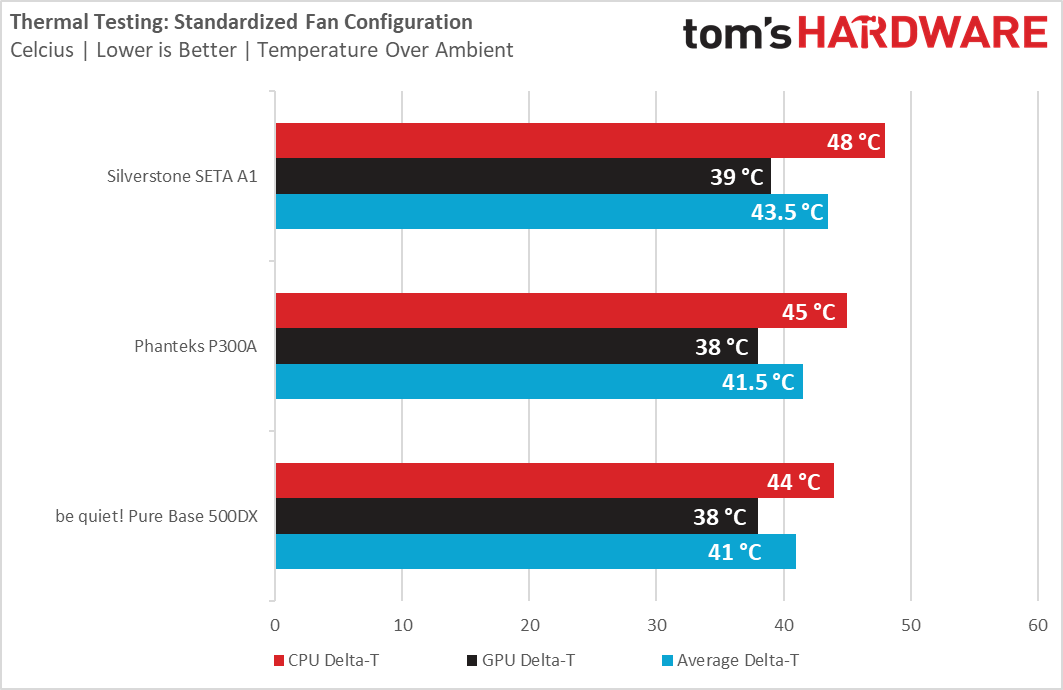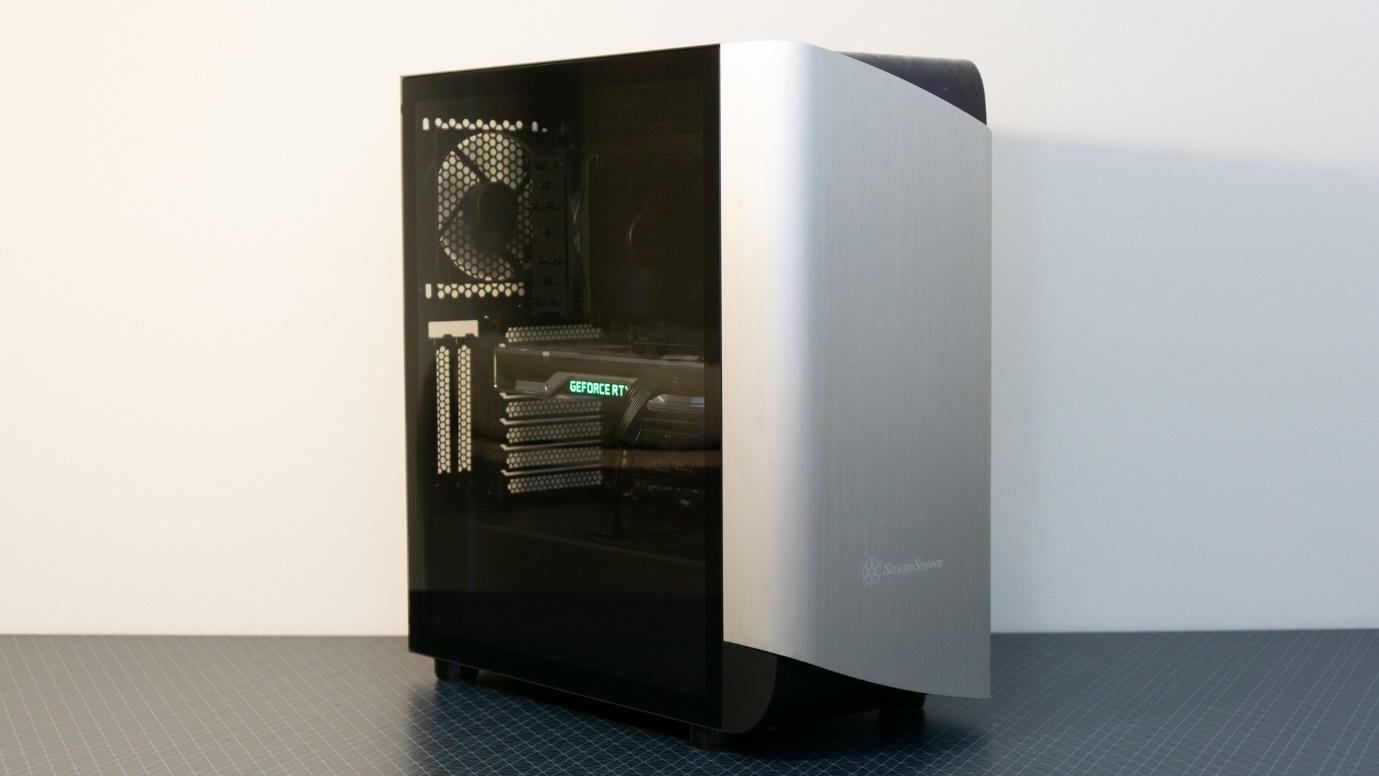Why you can trust Tom's Hardware
Benchmark Settings
For thermal and acoustic testing, we are using the following software and settings:
| CPU Clock | i9 9900k: 4.6 GHz (46x 100MHz) @ 1.1v | Row 0 - Cell 2 |
| GPU Clock | RTX 2070 Super: Stock | Row 1 - Cell 2 |
| GPU Driver | Nvidia GeForce 445.87 | Row 2 - Cell 2 |
| Case & CPU Fan Speeds | 100% | Row 3 - Cell 2 |
| GPU Fan Speeds | 75% | Row 4 - Cell 2 |
Test Results
The Silverstone SETA A1 comes with three fans, one 120mm exhaust unit and two huge 200mm fans at the front intake. These fans can spin at up to 1200 RPM for the 120 mm unit and 800 RPM for the 200mm fans. We tested their minimum speeds and found that all three fans are happy to spin at about 400 RPM when things need to stay quiet. It is worth noting that the bearings of the fans were quieter after warming up. They added .5 dB of noise during idle when we had just started the system.
Acoustic Results
For our acoustic tests, we run three scenarios: CPU full load, CPU and GPU full load, and an optimized idle. The CPU Full Load test runs the CPU and case fans at their maximum speed. For the CPU and GPU full load acoustic test we add the Nvidia RTX 2070 Super FE at 75% fan speed, because in practice it never runs at 100 percent and is far too loud when it does.
For the optimized idle, we run the GPU fan speed at 40 percent (the 2070 Super FE GPU does not have a Zero-RPM mode), and run the CPU and included case fans at the lowest speed they will spin at.
In the acoustic tests, the SETA A1 didn’t impress. We would have expected the huge 200mm fans to keep the system very quiet. But alas, the single 120mm unit at the rear seems to pour salt onto those hopes. In the optimized idle scenario with all fans running at the lowest speed they can, the SETA A1 put out a slightly higher decibel reading than be quiet!’s open mesh Pure Base 500DX, though still lower than the Phanteks Eclipse P300A.
With the case fans at full speed, we also measured a 1 dB higher noise level than the aforementioned cases, which is very peculiar given the two huge and thus supposedly quiet fans and restrictive front panel. Of course, you can achieve quieter results by limiting the 120mm fan’s maximum speed in the fan curves, but you’ll be sacrificing CPU temperatures.
Thermal Results
For the thermal tests, all case and CPU fan speeds are set to 100 percent. The i9-9900K is pegged at a 4.6GHz clock at 1.1v on all cores to ensure consistent power consumption across test scenarios, and letting the GPU run at 75 percent fan speed enables it to maintain its power target while maintaining one set reasonable fan speed, so that the temperature is the only variable that can change.
Get Tom's Hardware's best news and in-depth reviews, straight to your inbox.
Thermally, the SETA A1 also puts down some interesting results, though they’re not as concerning as its acoustics. The CPU temperature recorded was higher than the other two cases we have tested at this location. The SETA A1 got 1 degree warmer than the Phanteks P300A, which only has a single exhaust fan in its stock configuration compared to this case’s three fans. That said, the GPU temperature was excellent thanks to the fresh supply of cool air.
We removed the front filter and reseated the CPU cooler to see if that would help temperatures, but neither helped.
Standardized Results
To correct for differences in case fans, for the standardized test we remove the standard case fans and replace them with Corsair ML120 or ML140 units. Up to three fans may be installed, preferably one at the default exhaust location and two at the front intake, in the biggest sizes the case supports. The above tests are then repeated, but because the Corsair ML fans have absurdly high maximum speeds, we run those at 1200RPM for the load tests as no case fan should ever need to run above those speeds.


Silverstone’s SETA A1 puts down good numbers in the standardized test, which shows us that the included fans aren’t great performers. Although temperatures are a tiny bit higher than the open-mesh cases we’re comparing it against, the noise levels are a little lower, largely thanks to the solid front.
It’s also worth noting that although Silverstone says the chassis doesn’t, we found that it does, in fact, support a 140mm fan at the rear. A radiator wouldn’t fit, though.
Conclusion
When Silverstone’s SETA A1 landed on our test bench, we had high expectations. It costs $130, and for that money you should expect to get a case that offers high-end features, or at worst upper mid-tier quality with great performance. The SETA A1 does live up to that with a wonderfully manufactured exterior, but this isn’t a case you’ll want to constantly be making build changes in.
The tough-to-remove warning sticker was a bad start, but we can partially excuse that one as there are probably better ways to remove it than my chemical-happy inclinations. However, as soon as the panels came off and we started building in the case, the hard drive cage got in the way and lacked vibration-damping grommets, cable management was lackluster, the front panel came off with difficulty and the front filter required too much work to remove.
These issues could also be forgiven if the case performed very well in testing, but it didn’t do that either. Performance wasn’t terrible, but if you’re paying this much money for a chassis then you’re probably not expecting its large included fans to perform worse than Corsair’s loud ML spinners.
At a price point of $90, or maybe even $100 if you really like the brushed-aluminum slab, the Silverstone SETA A1 might be worth it, but we wouldn’t pay $130 for this case. While it doesn’t fail at anything, it doesn’t excel anywhere, either.
Niels Broekhuijsen is a Contributing Writer for Tom's Hardware US. He reviews cases, water cooling and pc builds.
-
Colif A silverstone in normal layout.. yawnReply
Hard to impress someone with an FT02 though :)
those fans are the newer version of the ones in my case. -
Sinitik Pretty generic case. It doesn't offer anything outside of that front RGB and even then it's nothing special. They should focus on their Raven series, they're not going to compete against NZXT and Enthoo like this.Reply -
Colif well, they are, but this is low end..Reply
They just haven't released it yet, its not on their website
47__YGaIZX8



